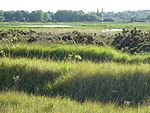Sizewell
East Suffolk (district)LeistonPopulated coastal places in SuffolkUse British English from June 2013Villages in Suffolk

Sizewell is an English fishing hamlet in the East Suffolk district of Suffolk, England. It belongs to the civil parish of Leiston and lies on the North Sea coast just north of the larger holiday village of Thorpeness, between the coastal towns of Aldeburgh and Southwold. It is 2 miles (3.2 km) east of the town of Leiston and belongs within the Suffolk Coast and Heaths AONB. It is the site of two nuclear power stations, one of them still active. There have been tentative plans for a third station to be built at the site.
Excerpt from the Wikipedia article Sizewell (License: CC BY-SA 3.0, Authors, Images).Sizewell
Sizewell Gap, East Suffolk
Geographical coordinates (GPS) Address Nearby Places Show on map
Geographical coordinates (GPS)
| Latitude | Longitude |
|---|---|
| N 52.207 ° | E 1.62 ° |
Address
Sizewell Gap
IP16 4UD East Suffolk
England, United Kingdom
Open on Google Maps










